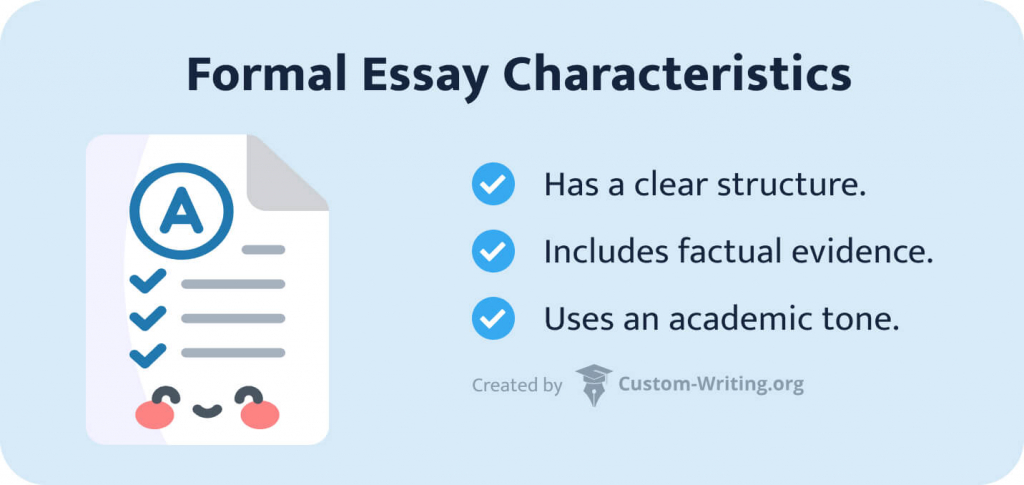A formal essay is a factual, research-based paper written in 3rd person. Students produce dozens of such texts throughout their educational careers. And there’s a good reason for it: learning how to write a formal essay helps students demonstrate their study progress and explore the compositional rules of different disciplines.

If you want to know how to write a formal essay in English, keep reading this comprehensive article by our custom-writing team.
It contains:
- An explanation of what a formal essay is
- A step-by-step writing guide
- Formal essay format and structure
- Formal essay example
- A collection of writing ideas
👔 Formal Essay Definition
A formal essay is a well-organized piece of writing with a straightforward introduction, body, and conclusion. This essay type often includes cited research, uses an academic tone, and is written in 3rd person. While producing a formal paper, it’s necessary to support your claims with factual evidence.
What Is an Informal Essay vs. Formal Essay?
Essays come in two formats: formal and informal (AKA personal.) They are distinct in style and context. You select between these options depending on the situation and the type of assignment required.
To tell them apart, simply keep an eye on these key aspects:
1. Purpose
- Informal essay is created to share an opinion or to entertain the reader.
- Formal essay aims to critically analyze facts, details, and ideas to prove a point.
2. Pronouns use
- Informal essay can address the reader directly and use 1st-person pronouns.
- Formal essay uses 3rd-person pronouns and never addresses the reader.
3. Objectivity
- Informal essay expresses the writer’s thoughts and tends to be more subjective.
- Formal essay strives to be objective and uses argumentation to support its claims.
4. Structure
- Informal essay doesn’t have to be rigidly structured.
- Formal essay should be well-structured and logical.
5. Thesis statement
- Informal essay’s thesis may be included in any section of the work or not explicitly stated at all.
- Formal essay’s thesis is always clear-cut and situated in the opening paragraph.
6. Word choice
- Informal essay often includes vernacular and expressive elements.
- Formal essay uses jargon and rigid academic language.
So, these types of writing are almost total opposites. Informal essays are only reserved for creative assignments, which means that most of the papers you write need to be formal.
Our article on creative essays can help you write an informal paper. But how do you craft a perfect formal essay? Keep reading to find out.
✅ How to Write a Formal Essay
Traditionally, a formal essay it’s composed of 3 sections: an introduction, 3 or more body paragraphs, and a conclusion. Let’s examine each part in detail.
Formal Essay Introduction
The introduction is what your essay opens with. Its primary goal is to capture the reader’s attention with a hook, concisely present the theme, and lead toward the thesis statement located at the end of the first paragraph.
Here is what you might want to keep in mind while writing the introduction:
- It should be related to the topic and give the reader an overall idea of the paper.
- It’s good to start your introduction with a quotation, an interesting fact, or a statistic.
- Try not to make the introduction too far-fetched or in-your-face.
- Avoid using questions in an introduction of a formal essay.
If you want some more inspiration for your introduction, check out our article on hooks in writing.
Now on to the thesis statement: the key idea of your essay. When working on it, keep in mind that it should answer the central question in your topic and reflect your essay’s overall structure. your essay’s overall structure.
Suppose your topic is related to the teaching methods involving poetry. In that case, the thesis statement can be like this:
Example:
Teaching methods that involve reading and writing poetry in elementary school are beneficial for children as they enhance their capacity for empathy, develop creativity, and help with self-realization.
Formal Essay Body
The next part of an essay is the main body paragraphs. They support the thesis statement with well-developed arguments and explore the topic in-depth. Each body paragraph starts with a topic sentence stating its main point. The length of a paragraph can vary, but the best option is to have between 4 and 7 sentences.
To make the text flow easily, you may use transitional words. Here are some examples:
- after all,
- for instance,
- on the one/other hand,
- initially,
- as a result.
How to Write a Formal Essay Conclusion
Lastly, every essay needs closure. A good conclusion summarizes the essay’s main ideas, includes a paraphrased thesis, and encourages the readers to think more about the topic.
The structure of a conclusion may change slightly depending on the subject. For instance, it can suggest some solutions to a problem, express an opinion, or give a recommendation. It’s important to remember that the conclusion is a part that emphasizes your essay’s most important points and doesn’t introduce new information.
If you’re curious about writing each essay part, check out our article on 5-paragraph essays.
✍️ Formal Writing Rules
Just like choosing the proper attire to wear to a formal event, we need to use the right words while writing a formal essay. Here are some suggestions that can help you maintain a formal tone in your paper:
Dos of formal writing
- Pay attention to your vocabulary. The words you will use in a formal essay will likely have a nuanced meaning. Make sure you know exactly what the terms mean, and do your best to sound precise.
- Use punctuation correctly. If you’re unsure of whether to use a punctuation mark or not, rewrite the sentence in a way that doesn’t require it.
- Use varied sentence structure. In formal writing, there is always a danger of sounding monotonous. Avoid repeating sentence structures to make your essay more readable.
- Provide references. It’s essential to cite every idea that you borrow. Try to paraphrase quotations from your sources: it will help you avoid plagiarism.
Don’ts of formal writing
- Avoid using pronouns. With words such as “I,” “me,” “we,” or “us,” an essay becomes informal. It also makes the author seem less sure of their claims.
- Refrain from slang and nonstandard diction. Slang will make your formal work less appealing to the readers. If you want to be taken seriously, it’s best to avoid colloquial units and use proper Standard English.
- Don’t use a casual tone. When composing a formal essay, incorporate the language and the expressions you would use while delivering a speech, not the words you use casually chatting with friends. An official tone suggests that you’re serious about the topic and respect your audience.
- Avoid passive voice. Passive verbs are difficult to read, and they are wordy. Use active voice to sound more straightforward and succinct.
Contractions in Formal Writing
A contraction is typically a combination of two words with an apostrophe, such as “don’t,” “isn’t,” “can’t,” and “wouldn’t.” When you work on a formal essay, it’s essential to be careful about contractions. It’s inappropriate to use them in academic writing, so make sure to write the full variant.
However, there are exceptions to this rule. For instance, when incorporating direct quotations, it’s essential to reproduce words exactly as they are put in the original, even the contractions. To learn more about it, be sure to check out the University of North Florida’s article on in-text citations.
What to Use Instead of “You” in an Essay
Another common blunder students make is using the “you” and “yours” pronouns to address the readers. Doing this can make the text overly casual and lead to misinterpretations.
How do you fix it? Our advice is to replace 2nd-person pronouns with such words as:
- readers,
- viewers,
- one,
- people,
- individuals,
- person,
- anybody,
- someone.
You can find more formal writing tips in this informative video from Smrt English:
Can You Use Parentheses in a Formal Essay?
It’s better to avoid using parentheses and dashes in formal academic writing. If the information you want to include in the essay is important enough, it should be a part of the sentence. Otherwise, you can simply omit it.
Can You Start a Sentence with “Because” in Formal Writing?
Starting your sentence with “because” in formal writing is not the best idea. The word “because” is a subordinate conjunction, which means it’s used to join the main clause to a subordinate clause, not to start a sentence.
🖥️ Formal Essay Format
Now that we’ve reviewed the writing process in depth, it’s time to examine the formatting. Formal essay type is normally written in MLA or APA style. If you’re required to use either of them, use these helpful guidelines:
MLA
- Write your name, the instructor’s name, your class, and the date in the upper left corner of the 1st page.
- Center the title and place it after the heading.
- Write your last name and page number in the upper right corner.
APA
- Create a separate title page.
- Make your title centered and written in boldface.
- Add your name, instructor’s name, school affiliation, and date.
- Write the number of each page in the upper right corner.
The remaining features are the same for both formats:
- Use 12-point Times New Roman font.
- Make your paper double-spaced without extra spacing between the paragraphs.
- Add a 1-inch margin on each side of the page.
- Make the opening line of each paragraph indented 1/5 inch.
- Line up your text flush against the left margin.
📑 Formal Essay Example
Here is an excellent sample of a formal essay that uses all the guidelines mentioned in this article. It will help you to produce a perfect paper of your own:
Example:
- Title: Adverse Effects of Sponsorship in the Sports Industry
- Introduction: Sponsorship plays a significant role in the sports industry these days. Many sports associations, football leagues, and clubs are entering partnerships with famous brands. However, it does not mean that all sponsorship has a good impact. This essay argues that a questionable sponsorship may undermine the image of a sport or a team and adversely influence the viewers.
- 1st Body Paragraph: Important sports events such as FIFA or The Olympic Games are sponsored by brands such as Coca-Cola, McDonald’s, Cadbury’s, and Budweiser. These are also brands that promote unhealthy lifestyles and foods that lack nutritional value and have high levels of sugar and saturated fats. Such kind of sponsorship aims to obtain a favorable change in the attitude toward the brand itself by connecting it with sport and a healthy lifestyle.
- 2nd Body Paragraph: While alcohol and junk food brands link themselves to sports bodies and active lifestyles, their main targets are children and sports fans. The growing popularity of products including potato chips, sugary drinks, and confectionary results in them being not simply a treat but a daily staple for many people. It creates various health issues, such as obesity, diabetes, and tooth decay.
- 3rd Body Paragraph: Finally, an association with a widely criticized brand is likely to damage the reputation of a team or even a sport itself (Crompton, 2014). People tend to expect their favorite teams to partner with fair, responsible sponsors. If the partnership is questionable, the fans may think that the sports body compromised their virtue for profit.
- Conclusion: To sum up, some kinds of sponsorship, such as alcohol or junk food, may use the sport’s image to attract more people and increase sales. It leads to the excessive consumption of sponsored products by children and teenagers and causes various health issues. It is also likely to affect the public image of a sports body.
For more information, check out Purdue OWL’s resources on various formatting styles.
Formal Essay Topics
- Stress management techniques
- The effects of coffee
- Negative effects of technology on children
- Causes and outcomes of organizational conflicts in sports
- Different types of friends
- Same-sex marriages in the United States
- Are early marriages harmful or beneficial?
- How do nutrition and hydration improve athletes’ performance?
- Is polygamy morally acceptable?
- Different features of sports business
- What characterizes friendship in the age of media?
- Positive and negative effects of tourism on environment in the Caribbean
- How does society treat single parents?
- How does the uninvolved parenting style affect child’s future well-being?
- The role of family relationships in Odyssey
- Financial concepts in sport finance
- Main features of a strong marriage
- The importance of media coverage for sport teams
- Reasons why students choose to get internship
- The role of stadiums in the sports industry
- The multiracial family: the Carters case analysis
- Characteristics of children’s sports
- Crucial factors affecting health fitness
- How is technology used in hotel management?
- Structure and operational context of Four Seasons
- What are the main qualities of a true friend?
- Different websites that promote rental properties
- The imperative aspects of tourism
- Importance of hotel training
- What factors determine adolescents’ adjustment after they experience parental divorce?
- How does tobacco use affect the human body?
- The importance of language and world view for communication
- What makes a combination of reinforcement and punishment in parenting efficient?
- The scientific approach of sports economics
- How does divorce affect children?
- Living on-campus vs. living off-campus when attending university: a comparison
- How does the New Moves program promote a healthy lifestyle?
- How to be an effective counselor
- Various types of restaurants in Ireland
- Carolina Dog’s characteristics
- Comparison of Monzameon’s The Love Suicides at Amijima and Tartuffe by Moliere
- Comparing homosexual and heterosexual families
- How is family presented in Everyday Use by Alice Walker?
- In what ways can Anaerobic Threshold be assessed?
- Is bad parenting a healthcare problem?
- Why student-athletes should benefit from sports
- Mind-body awareness and its health benefits
- Can punishment boost academic performance?
- Techniques to teach students swimming
- Issues faced by the sports licensing field
Thanks for reading through this guide! We hope that you found it helpful and now have a better idea of how to write an excellent formal essay. Don’t hesitate to share our article with a friend who may need it. Good luck!
Further reading:
- How to Write a Critical Thinking Essay: Examples & Outline
- What Is a Discourse Analysis Essay: Example & Guide
- How to Write a Narrative Essay Outline: Template & Examples
- How to Write a Précis: Definition, Guide, & Examples
🔍 References
- Formal Writing: University of Wisconsin–La Crosse
- Point of View in Academic Writing: St. Louis Community College
- Components of a Good Essay: University of Evansville
- Introductions & Conclusions: University of Arizona Global Campus
- How to Improve Your Academic Writing: University of York
- Nine Basic Ways to Improve Your Style in Academic Writing: University of California, Berkeley
- Academic Writing Style: Organizing Your Social Sciences Research Paper: University of Southern California
- Formal and Informal Style: Northern Illinois University
- Formal Writing: Davenport University: LibGuides


![Critical Analysis Essay Example & Writing Guide [2026]](https://custom-writing.org/blog/wp-content/uploads/2021/10/business-men-sitting-lawyers-s-desk-people-signing-important-documents-284x153.jpg)




![Critical Writing: Examples & Brilliant Tips [2026]](https://custom-writing.org/blog/wp-content/uploads/2021/02/fingers-note-report-journalist-filling-284x153.jpg)



